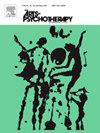Enhancing mental well-being through AI-generated art: Insights from EEG responses to Refik Anadol’s unsupervised at MoMA
IF 1.5
3区 心理学
Q3 PSYCHOLOGY, CLINICAL
引用次数: 0
Abstract
Art therapy has emerged as a promising avenue for enhancing mental health and emotional well-being. This study explores the therapeutic potential of engaging with AI-generated art by examining the neural and emotional responses elicited by Refik Anadol’s immersive installation, Unsupervised, at the Museum of Modern Art (MoMA) in New York. Thirty-one participants experienced a 20-minute session divided into four segments, during which their emotional states were assessed using self-reported questionnaires on valence and arousal, and their brain activity was monitored via EEG. Findings revealed significant increases in pleasure (d = 1.6) and excitement (d =.68) post-exposure, indicating enhanced positive affect. EEG data showed reduced gamma power in posterior brain regions and increased gamma power in anterior regions among those who reported an aesthetic experience (AE). Additionally, changes in Frontal Alpha Asymmetry (FAA), a marker associated with emotional and motivational states, correlated strongly with self-reported well-being (r = .65, p = .0005). These results suggest that AI-generated art can positively influence mood and emotional states, supporting its potential use as a tool in art therapy to promote mental health. This study demonstrates the feasibility of integrating physiological measures in naturalistic settings like museums, paving the way for future applications of art therapy in diverse environments to enhance psychological well-being.
通过人工智能生成的艺术来增强心理健康:从脑电图对现代艺术博物馆里Refik Anadol无人监督的作品的反应中得出的见解
艺术疗法已经成为增强心理健康和情感健康的一种有前途的途径。这项研究通过研究Refik Anadol在纽约现代艺术博物馆(MoMA)展出的沉浸式装置作品《无人监督》(Unsupervised)所引发的神经和情感反应,探索了参与人工智能生成艺术的治疗潜力。31名参与者经历了一个分为四个部分的20分钟的会议,在此期间,他们的情绪状态通过自我报告的效价和觉醒问卷进行评估,并通过脑电图监测他们的大脑活动。研究结果显示,暴露后的愉悦感(d = 1.6)和兴奋感(d = 0.68)显著增加,表明积极情绪得到增强。脑电图数据显示,在那些报告审美体验(AE)的患者中,脑后区域的伽马功率降低,而前脑区域的伽马功率增加。此外,与情绪和动机状态相关的标志额叶α不对称(FAA)的变化与自我报告的幸福感密切相关(r = )。65年,p = .0005)。这些结果表明,人工智能生成的艺术可以积极影响情绪和情绪状态,支持其作为艺术治疗工具的潜在用途,以促进心理健康。本研究证明了在博物馆等自然环境中整合生理措施的可行性,为未来在不同环境中应用艺术疗法以增强心理健康铺平了道路。
本文章由计算机程序翻译,如有差异,请以英文原文为准。
求助全文
约1分钟内获得全文
求助全文
来源期刊

Arts in Psychotherapy
Multiple-
CiteScore
3.20
自引率
11.10%
发文量
66
期刊介绍:
The Arts in Psychotherapy is a dynamic, contemporary journal publishing evidence-based research, expert opinion, theoretical positions, and case material on a wide range of topics intersecting the fields of mental health and creative arts therapies. It is an international peer-reviewed journal publishing 5 issues annually. Papers are welcomed from researchers and practitioners in the fields of art, dance/movement, drama, music, and poetry psychotherapy, as well as expressive and creative arts therapy, neuroscience, psychiatry, education, allied health, and psychology that aim to engage high level theoretical concepts with the rigor of professional practice. The journal welcomes contributions that present new and emergent knowledge about the role of the arts in healthcare, and engage a critical discourse relevant to an international readership that can inform the development of new services and the refinement of existing policies and practices. There is no restriction on research methods and review papers are welcome. From time to time the journal publishes special issues on topics warranting a distinctive focus relevant to the stated goals and scope of the publication.
 求助内容:
求助内容: 应助结果提醒方式:
应助结果提醒方式:


